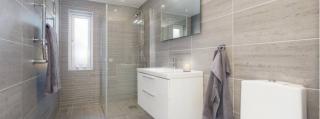JKB Handels GmbH c/o REGUS Berliner Allee 47 64295 Darmstadt
+49 (0) 6196 97276 19

Flooded floor just after showering is unfortunately a common sight in many bathrooms. How to protect your bathroom from flooding? The answer is simple: by installing an acrylic threshold.
The secret of a beautiful bathroom lies in two things: in a thoughtful and functional arrangement and in the order prevailing in it. While the refurbishment or construction of a bathroom is carried out down to the smallest detail, maintaining it clean can be difficult after the initial use. Fortunately, there are some clever and affordable ways that Steigner can offer. One of them is the acrylic threshold.
Acrylic threshold is an aesthetic strip that effectively stops water from pouring out of the shower and onto the floor. It can be mounted directly on the floor when using a barrier-free shower tray or on the edge of a shower tray in a classic shower enclosure. The transparent form makes the acrylic threshold almost invisible and it adds to the bathroom’s sophisticated, minimalist look while being functional. Often, the acrylic threshold is treated as a type of a seal for a shower enclosure.
The installation of the threshold itself is easy and it can be done without the need of professional help. Each threshold has an acrylic adhesive applied to it. Gluing the threshold onto thee floor takes a few moments. Just peal off the red security tape and apply the threshold in the designated place. Then wait 24 hours before first contact with water. If the threshold is placed over grout, we advise that a little bit of transparent silicone be used.
In our online Amazon store there are two models of acrylic threshold available: 5 mm or 10 mm in height (both 10 mm wide), each of them can be 30 cm to even 2 meters long! Steigner consultants will be happy to help you choose the right variant. We encourage you to contact us with any questions you might have.